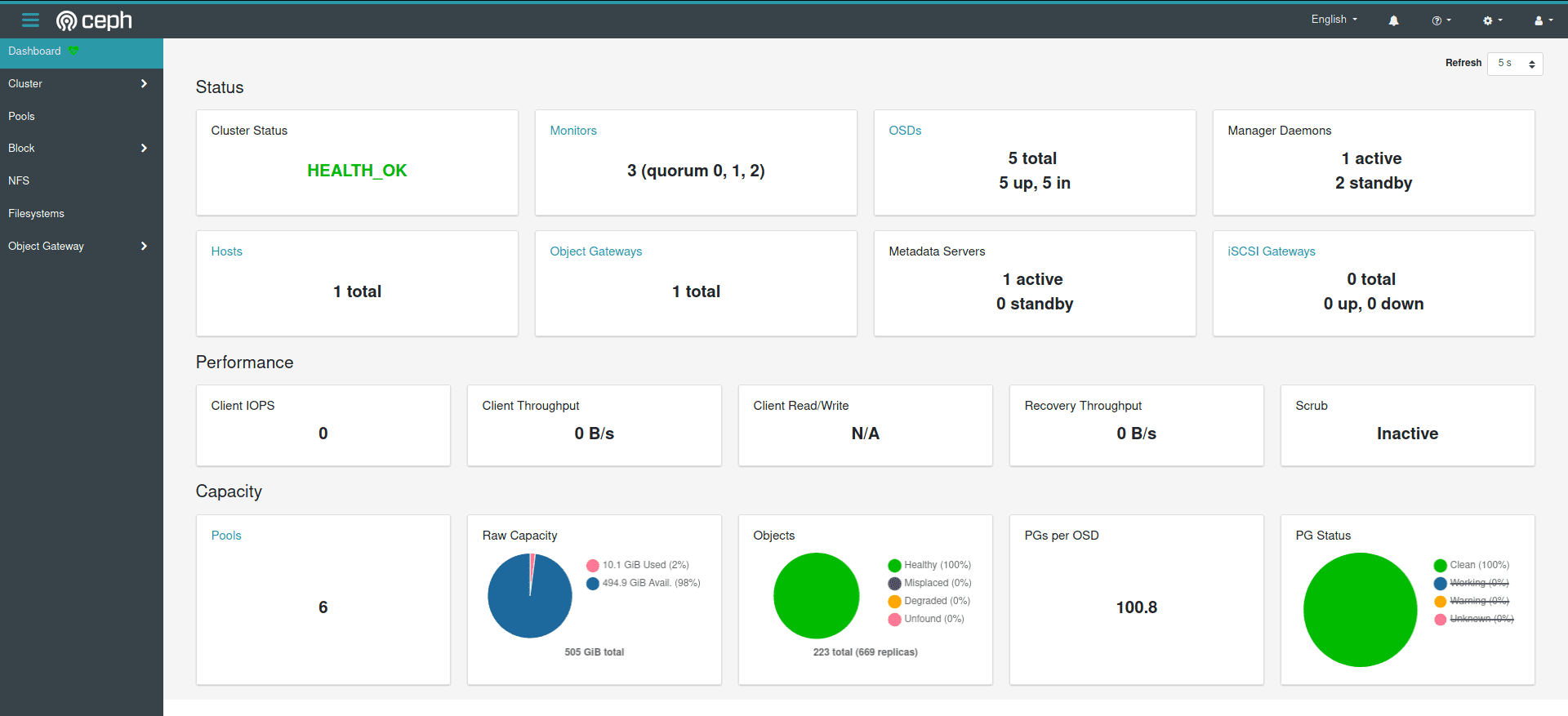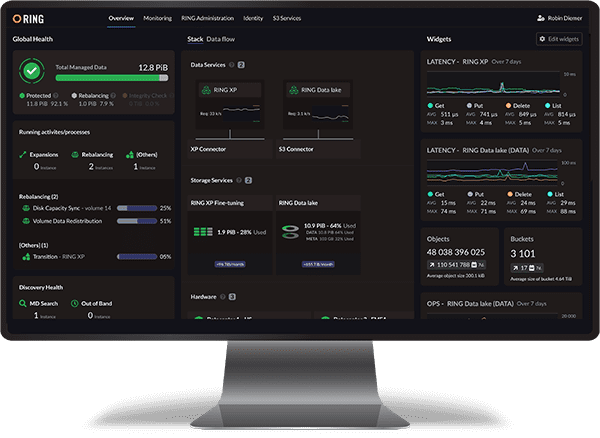Request a Demo
Join a 30 minute demo with a Cloudian expert.
Object storage platforms manage and store large amounts of unstructured data as discrete units called objects. Each object contains the data itself, metadata, and a unique identifier, making it possible to organize massive datasets without the limitations of traditional file systems.
Unlike block storage or file storage, which depend on hierarchical file structures or sectors, object storage utilizes a flat namespace, enabling unrestricted scalability and simplified data retrieval. Object storage platforms are well-suited for scenarios where high durability, scalability, and ease of access are required.
Object storage platforms can be categorized into on-premise and cloud-based solutions. On-premise solutions are deployed within an organization’s own data centers, offering maximum control over data governance, performance tuning, and security policies, and also significant long-term cost advantages. Cloud-based solutions are hosted by third-party providers and deliver scalable storage via the internet. This article focuses on on-premises solutions.
In this article:
A defining feature of object storage platforms is their inherent scalability. Unlike traditional file or block storage systems that might hit structural or performance constraints as data volumes increase, object storage can accommodate petabyte-scale growth without complex reconfigurations. The architecture allows new storage nodes to be added without service interruption, enabling organizations to scale out in response to changing data requirements and business needs.
This elasticity is critical in data-intensive environments where unpredictable data growth is common. With object storage, organizations can avoid migrating data to new systems as they scale, reducing operational overhead and minimizing risk. Providers typically guarantee performance levels even as capacity expands.
Durability in object storage refers to the protection of data against loss or corruption over time. Object storage platforms achieve high durability through replication, erasure coding, and geographic data distribution, ensuring that copies of data survive hardware failures and disasters. Many platforms offer durability levels of 99.999999999% (“eleven nines”), making them suitable for critical applications where data loss is unacceptable.
These systems continuously verify data integrity using checksums and self-healing mechanisms. Corrupt or missing data chunks are automatically detected and reconstructed without manual intervention. This level of built-in durability removes the burden of data maintenance from administrators and supports compliance with long-term retention policies or regulatory mandates.
Each object within an object storage platform is bundled with rich, customizable metadata. This metadata can store not only ownership and access information but also application-specific attributes, making it possible to perform fast and precise search, categorization, and retrieval operations. Unlike traditional file systems where metadata is limited, object storage allows for extensive tagging and can support analytics workflows directly on stored data.
Metadata management also plays a crucial role in automating workflows, enforcing policies, and integrating with third-party services. Applications can use metadata to trigger events (such as moving data to cheaper storage tiers) or to comply with legal hold requirements.
Object storage platforms reduce the total cost of ownership for managing large-scale, unstructured data. They leverage commodity hardware or public cloud infrastructure, avoiding the high capital expense of specialized storage arrays.
Operating expenses are also optimized as object storage eliminates much of the administrative complexity found in legacy systems. Automated repair, built-in data protection, and seamless scaling reduce operational workload, translating to fewer staff hours and lower support costs. For organizations facing data growth, object storage provides a sustainable economic model.
Object storage is suitable for backup and disaster recovery because it provides durability, scalability, and geo-distribution. Enterprises can back up massive volumes of data, automatically distributing objects across multiple physical locations or regions. The flat namespace and high addressability of objects simplify management, while integrated versioning and retention policies enable reliable point-in-time restores after accidental deletion or ransomware incidents.
Organizations benefit from object storage’s pay-as-you-go or capacity-based pricing, as well as from immutable storage options that are resistant to ransomware. Backup workflows leverage offsite, cloud-native repositories instead of outdated tape or disk solutions, meeting modern recovery time objectives (RTOs) and recovery point objectives (RPOs) efficiently.
For long-term data archiving, object storage meets both regulatory compliance and budgetary needs. Retaining vast stores of inactive or infrequently accessed data—such as medical records, historical logs, or email archives—becomes feasible thanks to cost-effective, high-latency object storage “cold” tiers.
Object storage’s metadata capabilities also simplify e-discovery and auditing tasks during regulatory reviews or litigation. Fine-grained tagging and indexing allow organization-wide searches and retrievals, making archived data accessible when required, without significant overhead or complexity.
The explosion of rich digital content—images, video, audio, and documents—has driven adoption of object storage for content management systems and media delivery platforms. Object storage platforms support massive repositories of content, offering high throughput and parallel access, which is critical for streaming, web hosting, and content distribution networks (CDNs).
Content delivery benefits from object storage’s geographic replication features, enabling low-latency access to users around the world. Integration with cloud-native APIs and popular frameworks accelerates development and content workflows, while storage policies optimize performance and cost for both hot and cold content.
Modern analytics and machine learning initiatives often leverage data lakes built on object storage. A data lake allows organizations to ingest, store, and analyze vast and diverse datasets—structured, semi-structured, and unstructured—without needing to predefine rigid schemas. Object storage’s native scalability and support for large objects make it the foundation of open data lake architectures.
These platforms enable batch and real-time analytics workflows by providing standardized APIs for data access, and their metadata enrichment supports advanced cataloging and data governance. Native integration with analytics tools and compute engines simplifies the entire data pipeline, from ingestion to visualization.
Object storage is suitable for AI workloads because it provides massive scalability, high-performance access, and cost-effective capacity for vector datasets that can reach petabyte scale. Enterprises can store billions of high-dimensional vector embeddings, supporting index files, and conversation history across distributed infrastructure while maintaining millisecond-level query response times. The flat namespace and S3-compatible APIs simplify integration with existing AI frameworks and machine learning pipelines, while horizontal scaling accommodates growing model complexity and user context requirements.
Organizations benefit from object storage’s ability to keep vast amounts of inference data online rather than archived, supporting the persistent context that modern AI applications demand. AI workflows leverage the platform’s proximity to compute resources and high throughput capabilities, eliminating data movement bottlenecks that traditional storage architectures create when feeding GPU clusters and real-time inferencing operations.

Cloudian HyperStore Object Storage Software is an enterprise-grade, software-defined storage platform for managing massive volumes of unstructured data at scale. Built for AI-ready performance and secure, hybrid-cloud integration, HyperStore empowers organizations to maintain full data sovereignty while delivering high throughput and bulletproof ransomware protection.
Key features include:


Ceph is a unified, open-source storage platform that supports object, block, and file storage within a software-defined system. Designed for scalability, resilience, and hardware independence, it enables organizations to consolidate multiple storage workloads onto a single infrastructure layer.
Key features include:


Dell ObjectScale is a software-defined object storage platform for Kubernetes-native environments. It offers S3-compatible object storage that runs on Dell infrastructure or other supported hardware, helping ensure availability, consistency, and multi-tenancy for enterprises.
Key features include:

Scality RING is a scalable, software-defined storage platform for managing large volumes of unstructured data across on-premises and hybrid cloud environments. It supports file and object storage within a unified namespace and enables multi-site replication. RING is suitable for enterprise workloads such as backup, archive, content distribution, and AI/analytics pipelines.
Key features include:


Quantum ActiveScale is a high-capacity object storage platform for long-term data retention, content repository management, and analytics workflows. It supports S3-compatible storage with data durability, making it suitable for archival, AI/ML, and backup workloads in on-prem and hybrid deployments.
Key features include:

Choosing the right object storage platform requires evaluating several key factors beyond basic performance and capacity. Here are the most important and sometimes overlooked considerations:
Related content: Read our guide to object storage solutions (coming soon)
Object storage platforms are important in modern data infrastructure, providing scalable, durable, and cost-effective storage for unstructured data. Their flexible architecture supports seamless growth, data protection, and efficient integration with cloud and analytics workflows. By enabling organizations to store, manage, and retrieve large volumes of data with minimal complexity, object storage empowers digital transformation and accelerates innovation across diverse industries and workloads.